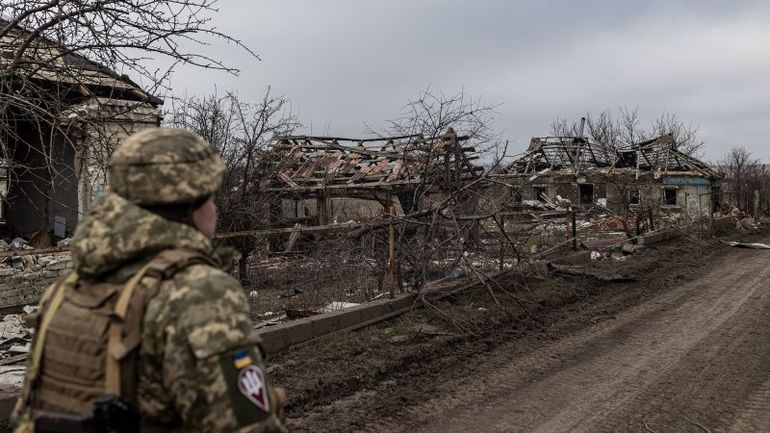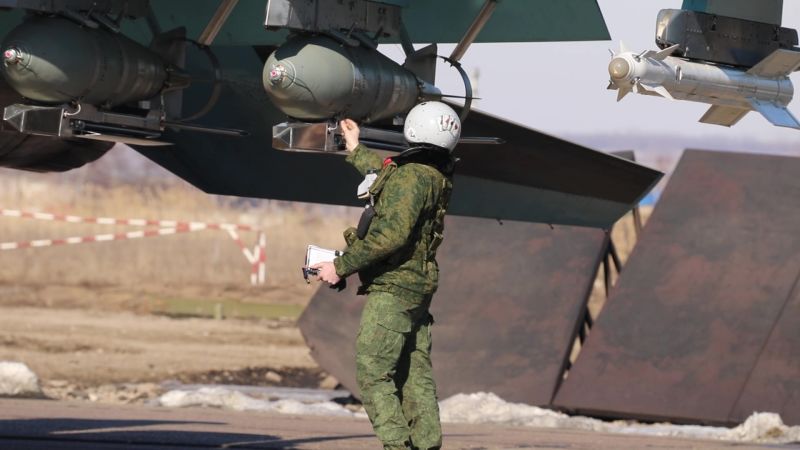
Ukraine's Defense Shaken by Russia's Latest Precision Bombing Tactics

The latest aerial bomb deployed by Russia is wreaking havoc on Ukrainian defenses, reshaping the battlefield dynamics. By retrofitting an old Soviet weapon into a guided bomb, Russia has introduced a devastating new element, creating massive craters and heavy casualties on the front lines.
Russia has started using a new powerful aerial bomb in Ukraine, which has greatly weakened Ukrainian defenses and shifted the balance on the front lines. This bomb is a modified version of a basic Soviet-era weapon, now capable of gliding and creating a fifteen-meter wide crater upon impact.
Known as the FAB-1500, this bomb weighs 1.5 tonnes, with almost half of it made up of high explosives. It is dropped from fighter jets flying from a distance of about 60-70 kilometers, making it difficult for Ukrainian air defenses to intercept. The FAB-1500 showcases Russia's strategy in the war, focusing on causing massive destruction before advancing to take control of territory.
Recent footage from the conflict in Donetsk region showcases the devastating impact of these bombs, as they target critical infrastructure such as power plants, factories, and residential buildings - all key locations for Ukrainian defense operations.
The FAB-1500 bomb is equipped with a guidance system and retractable wings that enable it to glide towards its intended target. According to Joseph Trevithick, a writer for TheWarZone, these bombs provide Russian tactical jets with a more powerful and effective long-range strike capability, while keeping pilots at a safer distance from enemy defenses.
Law enforcement officers walk past a building damaged as a result of shelling in Donetsk.
Law enforcement officers walk past a building damaged as a result of shelling in Donetsk.
One soldier from Ukraine’s 46th Separate Airmobile Brigade shared with CNN last week from the frontline town of Krasnohorivka in Donetsk. He mentioned that before they were only being shelled with artillery. However, now the Russians, referred to as orcs, have intensified their attacks on the town. They have started using air force assets, specifically the FAB-1500.
"Why do they use the FAB-1500? The damage it causes is extremely severe. If you manage to survive, you will definitely end up with a contusion."
"It greatly affects the morale of soldiers. Not all of our troops are able to handle it. While they have somewhat gotten used to the FAB-500, dealing with the FAB-1500 is a whole different challenge."
The Russian offensive in the Donetsk region has heavily relied on FAB bombs, especially in destroying Ukrainian defenses in Avdiivka, which was captured in February.
According to Yuri Ihnat, a spokesman for the Ukrainian air force, hundreds of air bombs were dropped in the days leading up to and during the battle of Avdiivka. In just 48 hours, 250 bombs were used in the direction of Avdiivka.
A member of the Ukrainian military, 59th Brigade, waits to take on new supplies before moving to a new position in November 2022 in Kherson, Ukraine.
A member of the Ukrainian military, 59th Brigade, waits to take on new supplies before moving to a new position in November 2022 in Kherson, Ukraine.
Chris McGrath/Getty Images/File
Related article
US officials have stated that they were well-prepared for a possible Russian nuclear strike in Ukraine in late 2022.
The FAB-1500, which is part of a family of Soviet-era 'dumb bombs', is currently being converted into a cost-effective and powerful missile at a plant located near Moscow.
Justin Bronk, a senior research fellow at the Royal United Services Institute in London, explains that the manufacturing of glide kits poses a challenge, but there is a plentiful supply of the basic explosive package.
This means that the Russians possess substantial firepower to target fixed defenses, leading to higher Ukrainian casualties. However, this firepower has not yet been sufficient to significantly alter the frontlines.
Ihnat mentioned to CNN that while the transformation is neither cheap nor quick, it is still much more affordable compared to the cost of a missile, which can run into millions of dollars. In comparison, the cost of this transformation is just a fraction of that of a missile.
Russian military bloggers first started talking about the weapon in September last year when its accuracy was being tested. The Fighterbomber telegram channel reported that after numerous trials and errors, a FAB-1500 successfully hit its target during combat testing for the first time.
Final checks on bombs before flight of the crew of Su-34 Fighter Bomber on March 8.
Final checks on bombs before flight of the crew of Su-34 Fighter Bomber on March 8.
Fighterbomber, a popular source close to the Russian military with almost half-a-million subscribers, reported that a newly developed glide kit has extended the range of the bombs. They also mentioned that the FAB-1500 is accurate to within five meters.
Within a few weeks, reports from both Ukrainian and Russian sources mentioned the use of a massive bomb in Kherson in the south and Kharkiv in the north.
In January, Russian Defense Minister Sergey Shoigu visited the plant of the JSC Tactical Missiles Corporation - a major arms manufacturer - in the Moscow region. During the visit, he was shown the wrap-around wings designed for the bomb. The company claimed to have developed a new type of munition that could convert old free-fall bombs into high-precision weapons capable of gliding to their target.
The director of the plant excitedly told Shoigu that productivity had gone up by 40% since they started operating 24/7.
Bronk points out that the modified FAB bombs are limited to attacking stationary targets, which may not be effective in the ongoing conflict in eastern Ukraine where Russian forces are familiar with Ukrainian positions.
Residents of the easters Ukrainian village of Zhelanie choosing to be evacuated due to ongoing shelling (source: Anna-Maja Rappard/CNN)
Residents of the easters Ukrainian village of Zhelanie choosing to be evacuated due to ongoing shelling (source: Anna-Maja Rappard/CNN)
Anna Maja Rappard/CNN
Related article
People in eastern Ukraine, including soldiers and civilians, are becoming increasingly worried about the situation as Russia continues to make progress in the region.
Although Russian planes are dropping bombs, they are not immune to attacks. The Ukrainian air force has reported successfully shooting down multiple Su-34 fighters in the past few weeks. However, many of Ukraine's air defense systems are unable to reach planes that are 70 kilometers away.
Ihnat mentioned to CNN that although our air defense has improved, it is still not sufficient. The enemy's objective is not just to target our frontline positions, but also to use guided glide bombs to strike our rear command posts, supplies, and ammunition.
Adding on, Ihnat explained that the attack aircraft, such as the Su-35 and Su-34 bombers, do not come as close as they would prefer. With better long-range air defense, we would have the capability to intercept these jets at a greater distance from our frontlines.
The development of glide bombs has allowed the Russians to make better use of their tactical air force rather than relying solely on long-range bombers during the initial phase of the war. According to Bronk, the US Patriot system is the main defense with the capability to counter this threat, but Ukraine has a limited supply of these missiles due to delays in receiving further military aid from the US Congress.
Ukrainian officials, including President Volodymyr Zelensky, have been consistently requesting longer range air defense weapons to protect against Russian aerial attacks. Although Ukrainian pilots are currently training on F-16 combat aircraft, it is unlikely that these aircraft will be deployed over Ukraine until the second half of the year. However, the presence of these aircraft may deter Russian combat aircraft from approaching closer to Ukrainian airspace.
Ukrainian forces in Donetsk are facing frequent Russian air strikes, with sometimes over 100 in a day, as reported by the Ukrainian General Staff. The Russians, who had previously used heavy artillery to attack Ukrainian positions, are now using a large number of bombs to destroy Ukrainian defenses and leave them with no protection.
Editor's P/S:
The introduction of

















